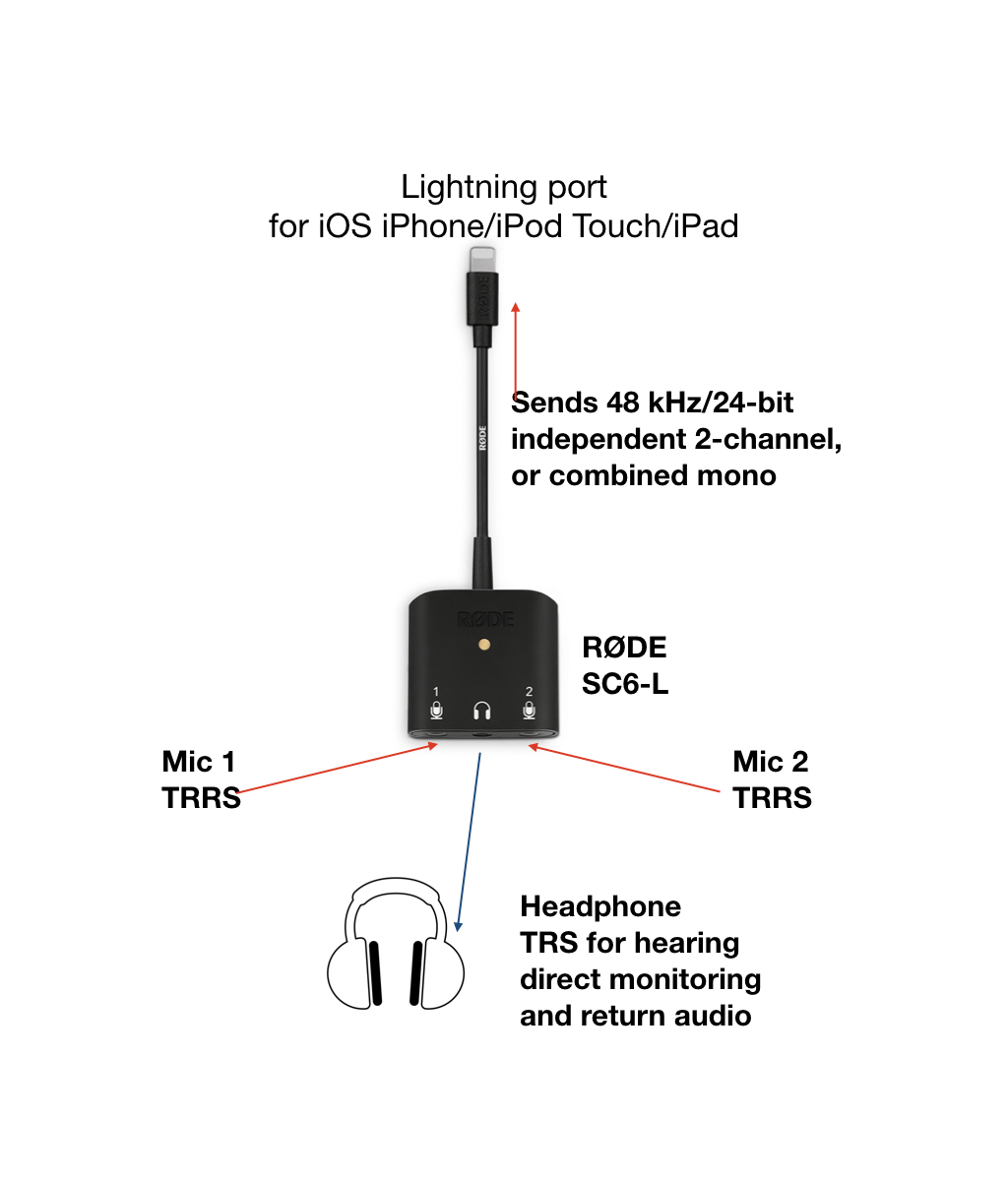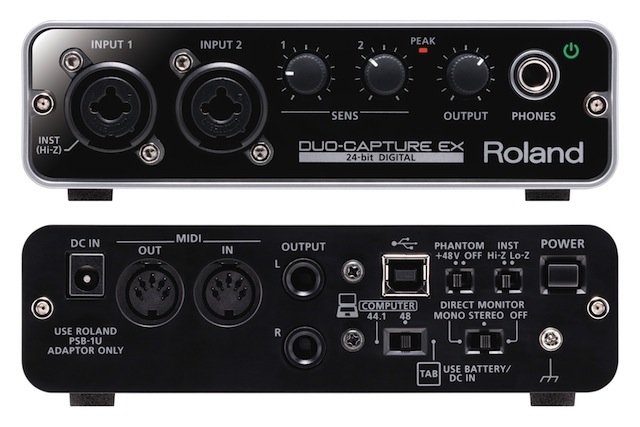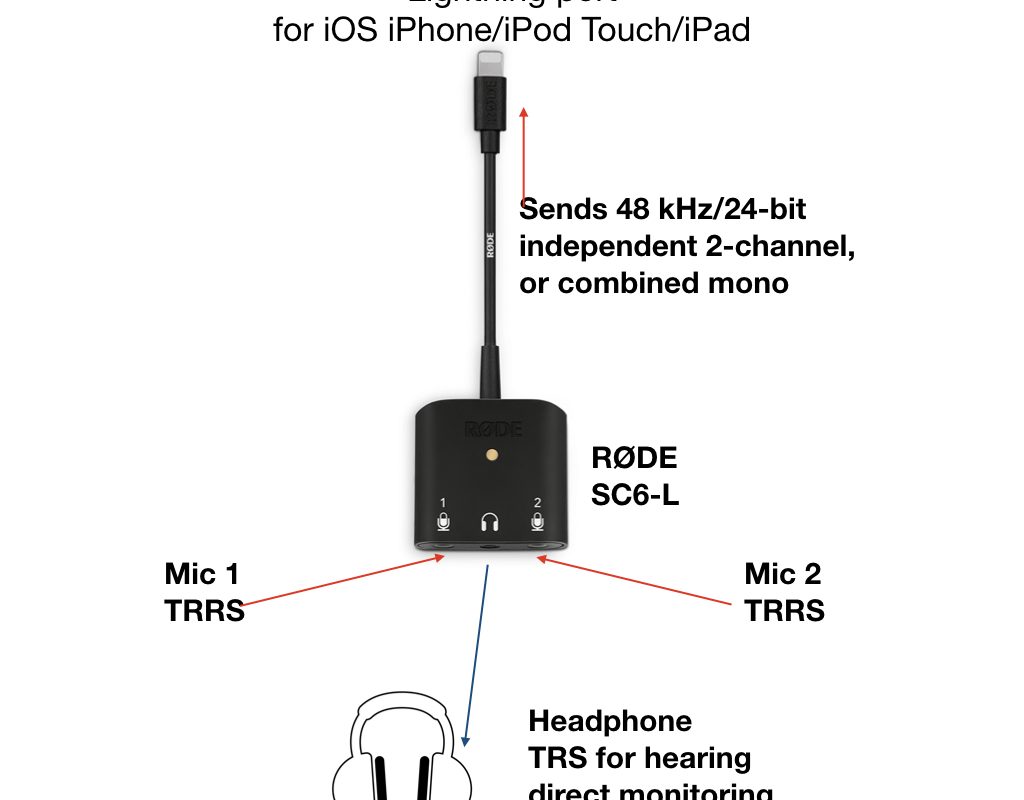
Although I have not yet received a review unit, I can already feel that RØDE’s recently announced US$79 RØDE SC6-L is likely to become a game-changer for compact 2-track field recording on iOS devices (iPhone, iPod Touch, iPad). Simultaneously, I also discovered that —two years after my plea for important improvements in the RØDE Reporter app for iOS— some of them were just added too, in addition to a firmware update for the RØDE i-XLR that I reviewed back then. Can you tell I am excited about these developments? Learn all the details ahead + two videos, preceded by a quick relevant history lesson.
Prior solutions to connect 2 mics into an iOS device for independent 2-track recording

Back in 2013, I reviewed the Roland DUO-CAPTURE (illustrated above) here.
Next, at the beginning in 2014, I published Five iOS-capable, dual-input balanced>USB audio interfaces compared (illustrated above). All mentioned so far are large and bulky, and many require batteries or external power. They are not exactly ideal for a single-person crew to carry around.
Later in 2014, I published Review: Tascam iXJ2 preamp/A>D enables dual-mic/2-channel opportunities for iOS mediography (illustrated above). The iXJ2 is much more compact than any of the others shown above. In fact, it’s pocket-sized. The iXJ2 has the old 30-pin connection for iOS, although several friends successfully adapted it to the newer Lightning port. Actor/voiceover talent Memo Sauceda has report that his now produces some audible noise. Sadly, the iXJ2 unfortunately offers no direct, latency-free monitoring.
Many users of the iXJ2 innocently fell into the TRRS trap (see TS/TRS/TRRS/TRRRS: Combating the misconnection epidemic, illustrated above) when inappropriately attempting to monitor directly from the iOS device via its own analog port (which is gradually disappearing anyway) by plugging a TRRS earbuds device, which would unfortunately confuse the audio/video recording apps and override the prior selection of the digital input. Even after I educated some of them that it could only work if the headphone connected to the iOS device were TRS (not TRRS), live monitoring was still app-dependent, so they had to deal with the latency (delay) when monitoring live. Also, adjusting the gain of each source with the iXJ2 was cumbersome since the two potentiometers (“pots”) were ganged together, so you had to hold one still with one finger while moving the other.
Several interfaces for a single source, single-track
I also reviewed several interfaces designed for a single source and to be recorded on a true mono or fake stereo/dual mono with identical content on each track. However, I won’t list them in this article, since this article is a first-look of the SC6-L, which offers discreet 2-track recording (with the option of combining to mono).
RØDE SC6-L: “Here I come to save the day!!?!?”
https://www.youtube.com/watch?v=e3PiaQm—0
https://www.youtube.com/watch?v=mfn01O6zV5g
Although I don’t have all of the details yet, and have not yet received a review unit from RØDE, I am very optimistic about the superficial information I have so far:
- The US$79 SC6-L (B&H) is evidently compact (even pants-pocket sized).
- Like the single-input RØDE i-XLR (reviewed here), the RØDE SC6-L apparently offers a direct-monitoring output for latency free monitory.
- To save physical space, the SC6-L offers gain adjustments via software, thanks to the free, updated RØDE Reporter app, where RØDE has apparently taken into account at least some of my suggestions in my i-XLR review a couple of years ago. (It is not yet clear whether the gain can be adjusted independently for each mic input via the RØDE Reporter app, but I hope so.)
- The SC6-L offers both discreet 2-channel mode (to record each source on a separate track, for more control during editing) and a combined mono mode, for live broadcasting or live-to-drive situations, where no post-production is to occur.
- Gain adjustments set in the RØDE Reporter are saved in the SC6-L hardware, so the SC6-L will remember the settings when used with another app that does not support the SC6-L fully (i.e. an app that doesn’t control the SC6-L hardware completely, but can receive its output, nevertheless).
- The SC6-L’s only microphone inputs are TRRS 3.5 mm, for direct connection to virtually any combination TRRS microphones. Those include RØDE’s own smartLav+ microphones (Amazon — B&H) where two will come included with the upcoming RØDE Mobile Interview Kit, any of RØDE’s shotgun microphones which terminate in TRRS, or even TRRS microphones from third-parties like the handheld iRig Mic from IK Multimedia (Amazon — B&H).
- A head-mounted TRS microphone like the ModMic 5 from Antlion Audio (which I most recently covered here, Amazon link) could also be connected to the SC6-L via RØDE’s SC4 3.5mm TRS to TRRS Adaptor (Amazon — B&H).
- Even XLR-balanced microphones like the RØDE Reporter microphone (reviewed here, Amazon — B&H) or Senal ENG-18RL (reviewed here, B&H) can be connected and used with the SC6-L using either an iRig Pre from IK Multimedia (Amazon — B&H). The iRig Pre not only adapts the signal from balanced to unbalanced and offers optional phantom power (only for condenser mics that need it, not for dynamic mics like the ones listed), the iRig Pre also acts as a pre-preamplifier, boosting the signal so the SC6-L will receive a stronger mic-level signal from a dynamic microphone, or even from an electret condenser one.
- It is not yet clear whether the SC6-L includes a hardware limiter, the way the Tascam iXJ2 (covered earlier in this article) and the Sennheiser HandMic Digital (reviewed here, Amazon — B&H) both do. However, at least I know that the SC6-L indeed offers 48 kHz sampling frequency (see All audio production & distribution should go 48 kHz. Learn why.) at 24-bit resolution. With 24-bit resolution, we can be more conservative with our recording level, recording with peaks at -12dB and knowing that the final recording will be able to be boosted in post without noticeable artifacts, as covered in Understanding 24-bit vs 16-bit audio production & distribution.
From what I can see, either by itself for US$79 (B&H) or in the RØDE Mobile Interview Kit for US$199 (B&H), the RØDE SC6-L interface will bring discrete 2-track compact iOS recording to a new level of flexibility and portability, and will also offer a mono mode, for those situations where it is used live or live-to-drive, when it is desired to combine both sources into a mono signal. That’s why the RØDE SC6-L will likely be the messiah of compact 2-track recording on iOS. Stay on my mailing list to be sure to see this upcoming review, and all of the others…
(Re-)Subscribe for upcoming articles, reviews, radio shows, books and seminars/webinars
Stand by for upcoming articles, reviews, and books. Sign up to my free mailing list by clicking here. If you previously subscribed to my bulletins and no longer receive them, you must re-subscribe due to new compliance to GDPR. Most of my current books are at books.AllanTepper.com, and my personal website is AllanTepper.com.
Si deseas suscribirte (o volver a suscribirte) a mi lista en castellano, visita aquí. Si prefieres, puedes suscribirte a ambas listas (castellano e inglés).
Suscribe to his BeyondPodcasting show at BeyondPodasting.com.
Subscribe to his Tu radio global show at Turadioglobal.com.
Subscribe to his Tu salud secreta show at TuSaludSecreta.com.
Subscribe to his CapicúaFM show at CapicúaFM.com.
Save US$20 on Project Fi, Google’s mobile telephony and data
Click here to save US$20 on Project Fi, Google’s mobile telephone and data service which I have covered in these articles.
FTC disclosure
No manufacturer is specifically paying Allan Tépper or TecnoTur LLC to write this article or the mentioned books. Some of the other manufacturers listed above have contracted Tépper and/or TecnoTur LLC to carry out consulting and/or translations/localizations/transcreations. Many of the manufacturers listed above have sent Allan Tépper review units. So far, none of the manufacturers listed above is/are sponsors of the TecnoTur , BeyondPodcasting or TuNuevaRadioGlobal programs, although they are welcome to do so, and some are, may be (or may have been) sponsors of ProVideo Coalition magazine. Some links to third parties listed in this article and/or on this web page may indirectly benefit TecnoTur LLC via affiliate programs. Allan Tépper’s opinions are his own.
Copyright and use of this article
The articles contained in the TecnoTur channel in ProVideo Coalition magazine are copyright Allan Tépper/TecnoTur LLC, except where otherwise attributed. Unauthorized use is prohibited without prior approval, except for short quotes which link back to this page, which are encouraged!


